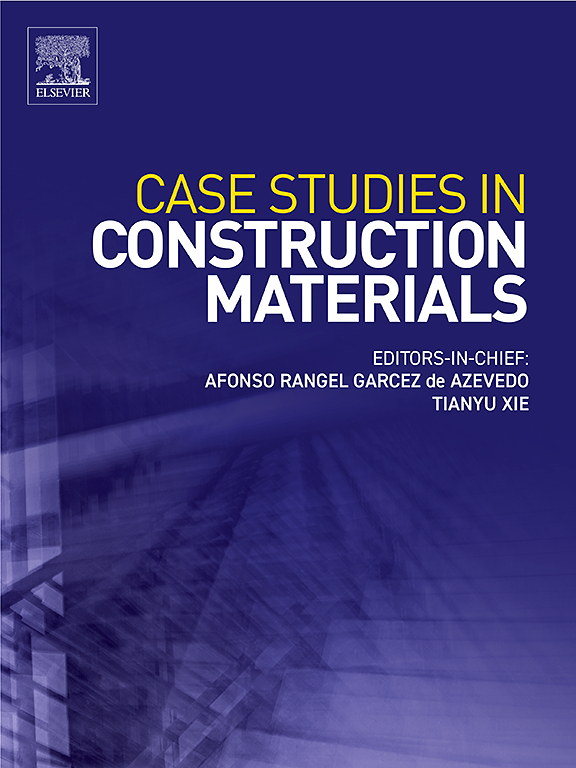Innovative gel method: Sustainable crack healing in ceramic powder geopolymer mortars via marine actinomycetes and bioactivated carriers
IF 6.6
2区 工程技术
Q1 CONSTRUCTION & BUILDING TECHNOLOGY
引用次数: 0
Abstract
This study addresses the urgent need for efficient self-healing methods in geopolymer mortars (GMs), which, with their favorable low-carbon character, are still vulnerable to microcracking and ongoing durability loss. GMs made of 50 % ceramic powder (CP) and 50 % granulated blast furnace slag (GBFS), synthesized with sodium hydroxide (2–12 M) and sodium silicate (Na₂SiO₃/NaOH = 1.0–2.0) at an initial sand-to-binder ratio of 2.5, were cured at temperatures of 40°C to 100°C. Artificial microcracks with diameters of 0.2 mm and 0.6 mm were created before applying liquid (+S) and gel-like (+J) formulations of S. pasteurii and marine actinomycetes isolated from Marmara Sea sediments for 90-day treatments. Compressive and flexural strength, water absorption, ultrasonic pulse velocity (UPV), and microstructural analyses via SEM/EDS, XRD, and FTIR were considered methods for assessing healing performance. The S1 +S group showed the best mechanical recovery, with compressive and flexural strengths of 42.92 MPa and 8.98 MPa, respectively, while S26 +S showed the best UPV value of 3245.44 m/s, attesting to effective internal consolidation. S13 +S showed the most balanced improvement in acetate-decomposing strains, with compressive strength of 37.20 MPa, flexural strength of 5.63 MPa, and minimized water absorption (7.44 %). Preservation of calcite precipitation and crystalline geopolymeric phases were confirmed via XRD. At the same time, increased carbonate and Si–O–Al bonding in FTIR indicated that the microbe-induced and inorganic polymerized structures occurred simultaneously. EDS also supported these findings, where increased Ca and C contents asserted localized CaCO₃ accumulation and increased peaks for Si and Al confirmed the unstable geopolymerization. All these findings place marine actinomycetes—especially acetate-decomposing strains—at the forefront of prospects for self-sustaining crack healing and structural reinforcement in green GMs.
创新的凝胶方法:通过海洋放线菌和生物活性载体在陶瓷粉末地聚合物砂浆中实现可持续的裂缝愈合
该研究解决了地聚合物砂浆(GMs)中高效自修复方法的迫切需求,这种材料具有良好的低碳特性,但仍然容易受到微开裂和持续耐久性损失的影响。以氢氧化钠(2-12 M)和硅酸钠(Na₂SiO₃/NaOH = 1.0-2.0)为原料,在初始砂胶比为2.5的条件下,以50% %的陶瓷粉(CP)和50% %的粒状高炉渣(GBFS)为原料,在40℃~ 100℃的温度下进行固化。在使用从马尔马拉海沉积物中分离的巴氏杆菌和海洋放线菌的液体(+S)和凝胶状(+J)配方进行90天的处理之前,先制造直径为0.2 mm和0.6 mm的人工微裂缝。抗压和抗弯强度、吸水率、超声脉冲速度(UPV)以及通过SEM/EDS、XRD和FTIR进行的微观结构分析被认为是评估愈合性能的方法。S1 +S组力学恢复效果最好,抗压强度为42.92 MPa,抗弯强度为8.98 MPa,而S26 +S组的UPV值为3245.44 m/ S,证明内部固结有效。S13 +S对酸分解菌株的改善最为均衡,抗压强度为37.20 MPa,抗折强度为5.63 MPa,吸水率最小(7.44 %)。通过XRD证实了方解石沉淀和结晶地聚合物相的保存。同时,FTIR中碳酸盐和Si-O-Al键的增加表明微生物诱导和无机聚合结构同时发生。EDS也支持这些发现,Ca和C含量的增加证实了局部的CaCO₃积累,Si和Al的峰的增加证实了不稳定的地聚合。所有这些发现都将海洋放线菌——尤其是分解醋酸盐的菌株——置于绿色转基因生物自我维持裂缝愈合和结构加固前景的前沿。
本文章由计算机程序翻译,如有差异,请以英文原文为准。
求助全文
约1分钟内获得全文
求助全文
来源期刊

Case Studies in Construction Materials
Multiple-
CiteScore
7.60
自引率
19.40%
发文量
842
审稿时长
63 days
期刊介绍:
Case Studies in Construction Materials provides a forum for the rapid publication of short, structured Case Studies on construction materials. In addition, the journal also publishes related Short Communications, Full length research article and Comprehensive review papers (by invitation).
The journal will provide an essential compendium of case studies for practicing engineers, designers, researchers and other practitioners who are interested in all aspects construction materials. The journal will publish new and novel case studies, but will also provide a forum for the publication of high quality descriptions of classic construction material problems and solutions.
 求助内容:
求助内容: 应助结果提醒方式:
应助结果提醒方式:


